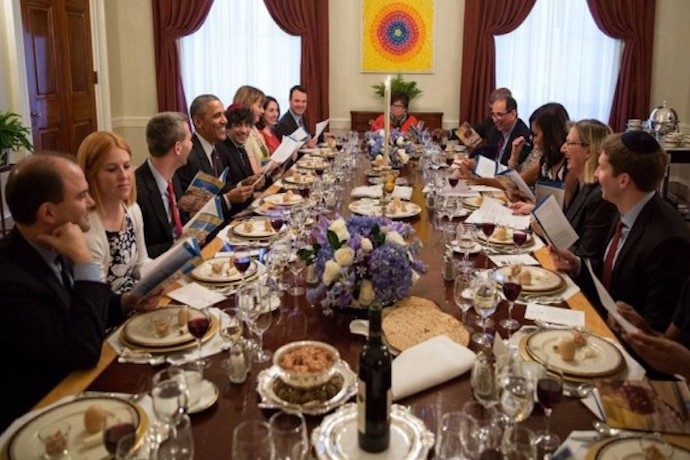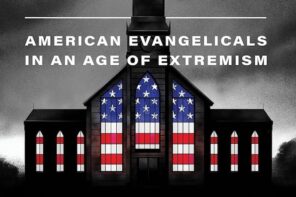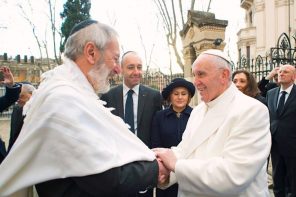As almost everyone who still has a wall calendar (does anyone still have a wall calendar?) realizes, Passover begins this year on Good Friday, and ends the following Friday or Saturday depending on your tradition. While the combination of Christmas and Hanukkah gets more play in the media (with over four decades of articles on the December dilemma and special attention last year, when Hanukkah started on Christmas eve), Easter and Passover are, in many ways, a more challenging combination for many interfaith families.
Christian-Jewish interfaith families come in many flavors and they react differently to combined holidays. There are families that are largely secular—they aren’t religious believers or religious practicers. While these families may want to attend a seder or two and an Easter dinner, they weren’t planning to mark Good Friday or follow any of the Passover food traditions and so, while their weekend will be busy, the holidays don’t pose particular challenges. Many families have chosen one tradition for their home. (Sometimes, these families forgo the traditions of the other half of the family, but more often they will join some of the family celebrations.)
A third, and growing, demographic of interfaith families actively strives to keep both traditions alive in their homes. They do this primarily by participating in 2 different religious communities, or in a third community—most often Unitarian Universalist, or a community specifically created for Christian-Jewish interfaith families, such as the Interfaith Family Project in suburban Washington, DC or the Interfaith Family School in Chicago, IL. Within these broad parameters, individual interfaith families obviously make their own decisions, have their own practices and traditions, and are happy (or unhappy) about the compromises that they’ve made. Essentially, there is no model for what “everyone” does in interfaith family life, any more than there is in any other religious life.
While Christmas, in particular, carries a great deal of emotional weight—from joy to dread—for both Christians and Jews (as well as theological significance for practicing, rather than cultural, Christians), the challenges posed by Easter and Passover can represent both logistical and theological minefields for interfaith families. First, while Hanukkah is determined by the Jewish calendar, Christmas is, of course, on December 25th. The two holidays don’t often, or always, co-inside. Even when they do, Hanukkah is a holiday of relatively minor religious significance and with few obligations. Interfaith families may well light the menorah in the shadow of a Christmas Tree, but the holiday overlap does not, necessarily, pose a problem. Neither their dates nor their stories overlap.
Not so, Passover and Easter.
First, and perhaps most uncomfortably, much Christian anti-Semitism is rooted in the Easter story, in Jesus’s betrayal by the Jews. Through much of European history, Passion plays, performed during Lent and Holy Week whipped up anti-Semitic violence, making Easter a holiday that brought real danger to Jewish communities. Even today, in the American context, Protestant and Catholic Easter liturgy can reflect that history, though there are also many moves to address the anti-Semitism inherent in the texts.
Similarly, even churches that want to celebrate Jesus’s Judaism and note that the Last Supper was a seder have a complicated relationship to Judaism. Hosting a seder to mark Maundy Thursday is an endlessly complicated practice, fraught with historical landmines and the potential for Christian supersecessionism. While there are Jewish partners in interfaith families who enjoy participating in Seders at their partners’ churches, many find the practice complicated at best and alienating at worst.
While the power differential between Christianity and Judaism makes Jewish celebrations far less problematic, within families aspects of the holiday table can also be alienating for Christian family members. A Passover seder is a (potentially) long, ritualized meal, some (or all) of which may take place in Hebrew. There are songs that are often included without sheet music, and when the Exodus story is recounted, it’s done in the first person plural, “When we were slaves in Egypt.” In the very first interview that I did while writing Beyond Chrismukkah, a Unitarian Universalist woman committed to raising Jewish children reflected that it took years for her to feel that she was included in that “we.” For more than a decade, she felt left out at her in-laws’ seder table, and even at her own, though she had done half of the cooking.
While the historical and theological (or social) tensions are fraught for some, many more experience Easter and Passover as a set of logistical challenges. Unlike Christmas and Hanukkah, Easter and Passover are scheduled, as it were, in ways that make them more likely to overlap, as they do this year. Because both holidays have assorted food restrictions, they can be hard to observe in parallel. Lenten practice varies, but many people give up indulgent foods, such as alcohol or chocolate, sacrifices that can make it hard to participate in a Passover seder, where alcohol is part of the ritual meal and chocolate is, simply, a fun and frequent dessert offering. (To offer a personal example, my best friend, the linchpin of my chosen family, usually gives up alcohol for Lent, though he also makes every effort to come to my seder if I’m hosting one. And so, he gives up alcohol for Lent except for the 4 ritual glasses at the seder table.)
Similarly, Jews who are observing Passover give up leavening and chametz (wheat, oats, barley, rye, and spelt) and Jews of Eastern European heritage often also give up kitniyot (corn, peas, legumes, and for some, rice). The Passover rules make all traditional Easter breads, hot cross buns, and light-as-a-feather biscuits and yeast rolls verboten for the Jew at an Easter table. Throughout much of the year, food is one of the easiest and most comfortable ways for interfaith families to share in each other’s traditions. Christmas cookies can honor grandmothers and family traditions without introducing theological disagreements about Jesus. They can even be made in homes that are otherwise exclusively Jewish. Latkes can appear for dinner one or two nights during Hanukkah, even as the dining table is decorated with an advent wreath. Food is so often the bridge for interfaith families, but the nature of Passover and Easter takes away that easiest place to connect.
I don’t mean to suggest that Easter and Passover cannot be combined successfully. In many interfaith families, people manage to do just that. One of the families that I interviewed during my fieldwork had chosen Judaism as their household religion, and they observed Passover from the night it began until they left Hebrew School on Sunday morning to drive to Grandma’s house for Easter dinner. The father, in this particular family, grew up on a hog farm in South Georgia where Easter dinner is a feast, including ham, biscuits, chicken and dumplings, and many kinds of pie. It’s the kind of country cooking common in Southern farm kitchens. From the moment they walk in the door, all of the food is permissible and stays permissible until they return home. Other families decide that Easter dinner will be Kosher for Passover, with lamb or roasted chicken instead of ham.
Similarly, there is a small cottage industry of Haggadot (Passover liturgies) specifically designed for interfaith families, that carefully explain traditions, intentionally universalize themes that traditionally refer only to the Israelites, pull in voices from other cultures and traditions, or provide sheet music to songs so that more people can follow along. These texts are predominantly in English and they transliterate any Hebrew to make them more accessible. Importantly, these Haggadot are sometimes directed at interfaith families, but many more are simply written by and for liberal and potentially secular Jews, and are comfortable for interfaith family seder tables.
Back in 2014 RD hosted a discussion over whether it was appropriate or not for Christians to host their own seders. The discussion was launched, appropriately enough, by a Christian writer in an interfaith marriage. But the issue in that discussion largely surrounded the phenomenon of families looking, for better or ill, to borrow from other traditions’ toolkits. For interfaith families on the other hand, Passover and Easter, or “East-over” as my sister has taken to calling it, is, in many ways, more of a balancing act, as families seek to honor competing observances and traditions even as they try to steer clear of everything from anti-Semitism to the potentially exclusionary language of the seder. Those challenges are thrown into particular relief on years like this one, when the holidays coincide.





